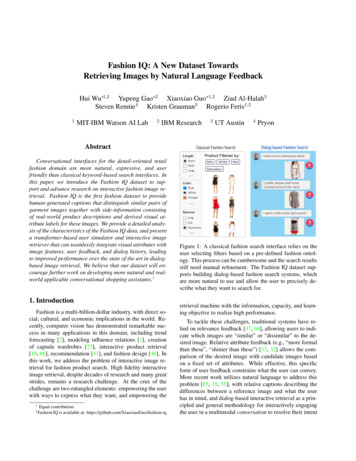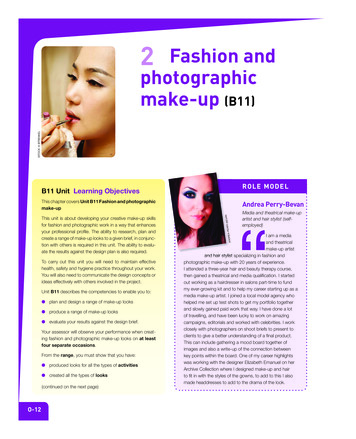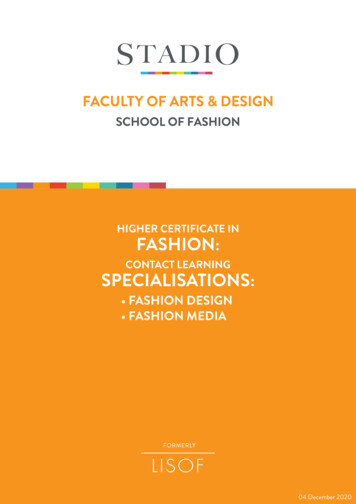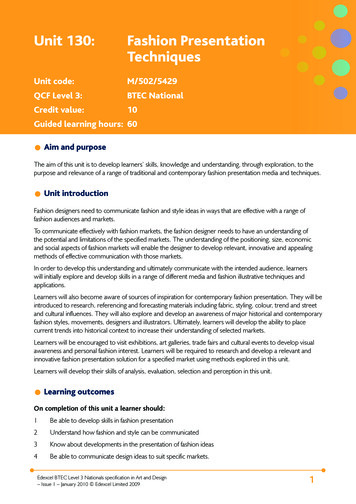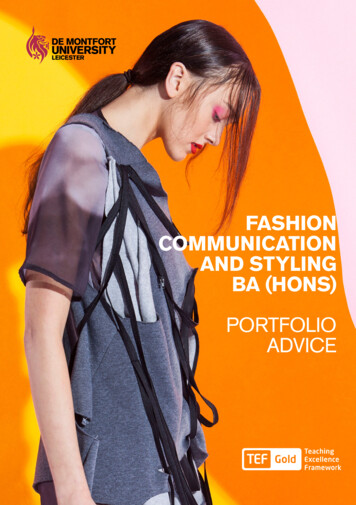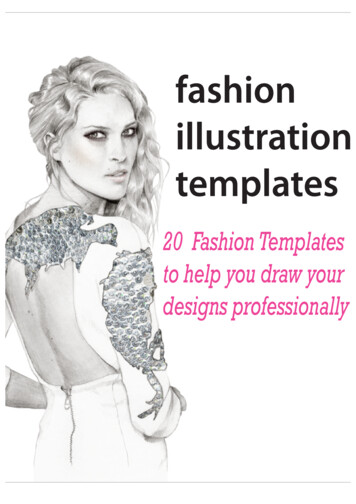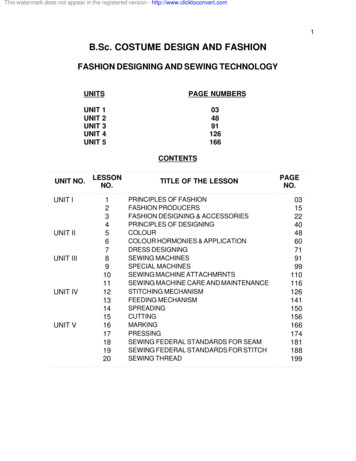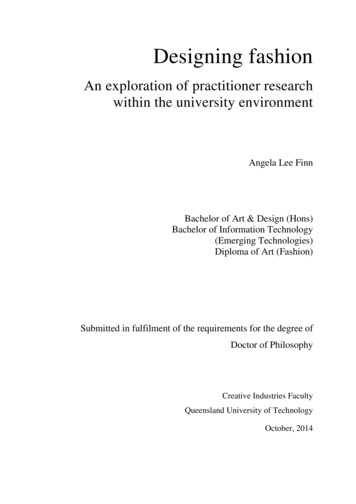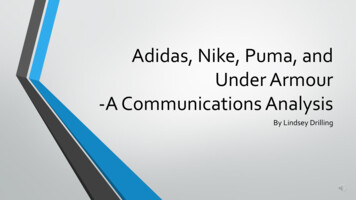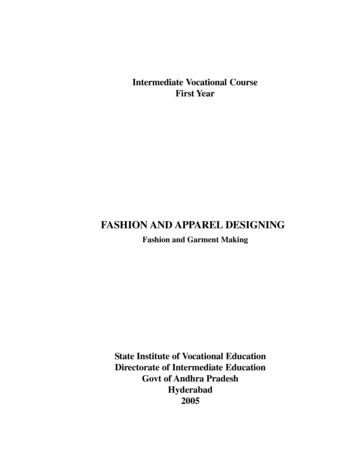
Transcription
Intermediate Vocational CourseFirst YearFASHION AND APPAREL DESIGNINGFashion and Garment MakingState Institute of Vocational EducationDirectorate of Intermediate EducationGovt of Andhra PradeshHyderabad2005
Fashion and Apparel DesigningAuthorDr. D. AnithaAssociate ProfessorDepartment of Apparel & TextilesCollege of Home ScienceANGRAU, HyderabadEditorDr. A. Sharada DeviUniv. Professor & HeadDepartment of Apparel & TextilesCollege of Home ScienceANGRAU, Hyderabad
CONTENTSS.No12TopicIntroduction to DesignElements of DesignPrinciples of DesignColour and Colour TheoryPg No1 -2122 - 31Properties of Colour/ Colour DimensionsColor TheoriesColour Wheels - Colour SystemsUse of colour in designing3Introduction to Elements of Fashion32 - 42Fashion terminologyFashion cyclesTheories of Fashion Adoption4Designing Process43- 50Theme based –designing fashion illustrations, coloursand texturesUse of colour and texture in rendering illustrations5Designers of India51- 60Basic Requirements of a DesignerIndian Fashion Designers6Fashion Fabric Information ServicesServices AvailableFabric Information61- 67
Fashion and Apparel DesigningLIST OF FIGURESTopicS.No1 Types of Lines2 Direction of Lines3 Optical Illusion through lines4 Effect of line spacing in dress5 Effect of Smooth & Flat and Soft & Clingy Fabrics onthin person6 Effect of stiff & bulky Fabrics on thin & thick person7 Types of Balance8 Various Proportions in Clothing Design9 Creating Emphasis in Garments10 Harmony in Clothing Design11 Achieving rhythm in dress design12 Intensity Scale13 Relation between hue, value and intensity of colours14 Additive Colour Wheel15 Subtractive Colour Wheel16 The Prang Color17 Warm Colours18 Monochromatic Colour Scheme19 Analogous Colour Scheme20 Complementary Colour Scheme21 Split Complementary Colour Scheme22 Traid Colour Scheme23 Fashion Cycle24 Story Board depicting the Theme25 Colour & Swatch board26 Illustration Board27 Flats28 Rendering Techniques for Various TexturesPg No1-67 - 1314 - 2021- 2821- 2821- 28
CHAPTER -1INTRODUCTION TO DESIGNGarments should be designed considering the three major aspectsstructure, function and decoration. It should be structurally effective andappropriate for the customer’s need and as per the day’s fashion.Functionally it should permit the activity a person performs wearing it,and decoratively appropriate to the garment and the wearer. Garments,which are successful in appearance, function, structure and decorationstimulates the purchaser to buy them. The above three aspects are fulfilledin a garment when the elements and principles of designs are met with.These elements of visual design have been defined as the basicingredients or components from which a visual design is made. One mustknow both the potentials and the limitations of each element. Althoughthe elements are unique and fundamental, they are not always mutuallyexclusive. For example, shape cannot exist without line and space.Understanding how and why a person responds to the variouselements & principles of design and knowing how to control and use themeffectively for a good design is an important aspect in designing. Thoughvarious authors group elements separately, the fundamental theory remainsthe same.
2Fashion and Apparel Designing1.1 ELEMENTS OF DESIGNI Line:Line refers to the edge or the outline of a garment and the style linesthat divide the space within a garment. It is an enormously useful and versatilerealistic tool that is made to function in both visual and verbal ways. Lineleads the eye in the direction the line is going, and divides the area throughwhich it passes, thus providing a breaking point in space. It defines a shape ora silhouette and conveys a mood or a character. Line can create visual illusions,such as height and width and also makes a figure look thinner or thicker.There are nine characteristics of line – path, thickness, evenness,continuity, sharpness of edge, contour of edge, consistency, length anddirection. These aspects or characteristics of line give it a powerful role indress. Line manipulates space: line divides it, encloses it, organizes it, pushesand pulls it, separates and contours it.Definition: Line is an elongated mark, the connection between two points, orthe effect made by the edge of an object where there is no actual line on theobject itself.In garments lines can be categorized in three ways: first is by type,second by direction and the last by application. All garments contain acombination of lines from each of these categories.A. Line types:According to the type, lines can be divided into three types - straight,curved, and jagged lines (Fig: 1).1. Straight line: All garments have some straight lines in them. These linesemphasize body angularity and counteract the roundness of the body. Straightlines are created in dress by seams, darts, hems or garment edges, pleats,hems, trims, braids, tucks, and panels. They create a feeling of elegancy, boldand powerful effects in a garment. When more straight lines are used in adress than necessary they can give a stiff look.2. Curved lines: These lines can be rounded and circular termed as full curveor somewhat flattened out called as restrained curve. Curved lines are lessconservative, formal and powerful than straight lines. In fact, circles
3Introduction to Designand curves make spaces look larger than they really are. They also increasethe size and shape of the figure. They add interest and smoothness. Theygive soft, gentle, youthful and flowing feeling. But too many curved linesin a dress at once can create a confusing look.a. Full curve: Emphasizes body curves, counters thinness and angularitygiving a young, youthful, feminine, dynamic character. In a dress full curvesare introduced through seams, garment edges and scalloped edges.b. Restrained curve: These curves slightly emphasize curves of the body.Yet they give soft, gentle, feminine and graceful effects. Soft, shallowcurves suggest comfort, safety, familiarity, and relaxation. These areintroduced in dress by seams, garment edges, princess lines, trims, gathers,draping and fabric pattern.3. Jagged line: These lines have sharp points like zigzags, which changethe direction abruptly due to their points. This type of line gives a feelingof jerky, busy, exited effect. They also emphasize angularity. When theyare used more than required these jagged lines can create a feeling ofconfusion in dress. As they are very noticeable their use should be carefullydone. Decorative fabric pattern and trim like rickrack can lead to this effect.Fig:1 TYPES OF LINESbcaa. Straight linec. Restrained curvedb. Full curved. Jazzed lineB. Line Direction:According to the direction, lines may be vertical, horizontal, ordiagonal.a. Vertical lines communicate a feeling of loftiness and spirituality. Theselines lead the eye up and down. They give the impression of added height
Fashion and Apparel Designing4and slimness. If worn by a thin person it makes the person look even tallerand thinner. They also give a feeling of dignity, strength, poise andsophistication. Vertical lines are found in a shirt front, princess lines, centerback seam, darts, pleats, tucks and in fabric pattern.b. Horizontal suggests a feeling of rest or repose as it is parallel to theearth and is at rest in relation to gravity. Therefore compositions in whichhorizontal lines dominate tend to be quiet, relaxed and restful in feeling.These lines will direct the viewer across the garment, emphasizing its widthat that point. That is they give the impression of less height and more width.In other words they make a body look shorter and wider. So their placementis done where a wider and broader feeling is required. For example a bandor seam at the hipline will make the hips seem wider. Horizontal lines arefound at waistlines, hemline, wide neckline, sleeves, collars, panels, midriffsand in belts.c. Diagonal lines are slanted and they suggest a feeling of movement ordirection. Diagonal lines in a garment tend to slenderize the whole, morethan vertical lines. They are strong and draw attention to the area wherethey are used. Since objects in a diagonal position are unstable in relationto gravity, they are either about to fall, or in motion. Thus if a feeling ofmovement or speed is desired, or a feeling of activity, diagonal lines can beused. Their degree of slant determines their visual effect in clothes. If theyhave a vertical slant they give slenderness feeling and if they are horizontallyslant they add width. When these lines are combined with vertical lines, afigure seems the tallest as they tend to create a more slenderizing effect(fig 2 ). These lines are found generally in panels, seams, darts, ‘V’ necklines,collars & lapels, flared trousers ‘A’ line skirts, bias cut stripes and raglansleeves.Fig:2 DIRECTIONS OF LINESbcaa. Straight lineb. Horizontal linec. Diagonal line
Introduction to Design5C. Application of Line in garments:Lines are incorporated into clothing in the two basic ways - structuraland decorative.a. Structural lines: Structural lines are most noticeable if the fabric of thegarment is plain. They can be introduced through constructional lines likeseams, darts, fitting tucks and shirring. Structural line are also introducedby real or perceived edges of garment parts like outer edge of collars,sleeves, belts, hems, pockets etc. Creases and folds created by pleats, gathersetc also give structural line effect in a garment.b. Decorative lines: Decorative lines are created by adding details to thesurface of clothing. They are added simply to decorate the garment andmake it more interesting. They add style and personality. They can beformed by adding rows of buttons, topstitching, braids, piping, bias bindinglace edging, faggoting, ruffles, fringe etc. Fabric pattern lines such asstripes, plaids, herringbones, checks etc also add lines decoratively.D. Types of illusion created by line in dress:Different lines are mixed in garments. The ways lines are combinedproduce various, expected effects. Skillfully used lines can create variousvisual illusions.Lines lengthen an area more or less depending on the direction ofline “tails” as shown in fig 3. When diagonal lines are added to each end ofa straight line pointing towards the center, it looks shorter than when thediagonal lines on each end keep the eye moving out.A horizontal line and vertical line of the same size when placedtogether the horizontal still appears to be small due to illusion.A vertical seam or an opening appears longer when it intersects ahorizontal belt or hem.In clothing, lines often combined into designs that appear to forman arrow, or the letters T, I or Y (Fig:3). These configurations cause certainoptical illusions. Lines that form an arrow tend to deflect the gazedownward. They shorten, or reduce the height of a person. Lines thatform a “T” also stop the upward movement of the eye. The height is againcut, but width is given to the top. Lines that form an “I” tend to give a
6Fashion and Apparel Designingvertical feeling that is contained at the top and bottom. They carry thegaze upward and make the body look somewhat taller and thinner. Linesthat form a “Y” keep the gaze moving upward even further. Theappearance of even more height is given to the body with a raisedcollar or a V neckline.Lines spaced far apart make the figure look larger than they arenearer (Fig:4). A panel at the center of the dress can create this effect.Also when the lines are bold, they draw the attention of the looker.Thick stripes create this illusion. They make a person look larger thanthey are actually are.FIG:3 OPTICAL ILLUSION THROUGH LINESFIG:4 EFFECT OF LINE SPACING IN DRESS
Introduction to DesignWhen lines cross each other, they draw the attention to that area.So illusion of width and height, thin and thick are all possible in a dress bytactful use of line in garments. It often helps one to conceal figureirregularities and move towards fashion form.II TEXTURETexture is the element of design that describes surface appearanceand feel. It also means the appearance of the fabric. Texture is a sensoryfeeling understood by sight as well as by touch. It is quality of roughnessor smoothness, dullness or glossiness, stiffness or softness. Some words todescribe the texture of fabrics are: rough, smooth, dull, shiny, firm, crisp,fuzzy, bulky, dull, etc. Textures can also be described as lightweight,medium weight, or heavy weight.There are two types of textures- structural texture, which is createdwhen fabrics or garments are manufactured, and added visual textures,which come when a design is printed onto the fabric surface. There arevarious components like fibers, yarns, fabrics and finishes that determinetexture.A. Determinants of texturea. Fibres: Fibres are hairline strands that are made into yarns. Fibers ofwool produce soft textures while that of linen produce a crisp textures.The short fuzzy fibers of cotton will produce a dull appearance due thefuzz. The smooth and long filaments like silk fibers and synthetic fibersmake fabrics that are shinny, smooth and cool touch fabrics.b. Yarn: Yarns are made from fibers when they are twisted together. Ayarn which has a low twist will produce a shinny texture because the naturalgloss of fiber is not lost in the twist, where as a highly twisted yarn on theother hand will give a rough texture since the fiber gloss gets lost in thetwist. Yarns that are looped or coiled in manufacture of yarn produce stretchfabrics. Such novelty yarns create interesting surface contours too.c. Fabric: Fabric is constructed either by weaving, knitting, felting, bonding,crocheting or braiding techniques. Often this construction of the fabricdetermines the texture. A satin weave of loosely twisted yarns producesshinny textures whereas knits absorb light and are dull textured.7
8Fashion and Apparel Designingd. Finish: Finish is given to fabric after it is constructed. It can impartor change the texture. Some finishes like sizing gives stiffness, moireingadds shine and watermark design to the fabric, calendaring gives shineto the fabric, singeing makes the surface smooth and napping makesthe fabric fuzzy.B. Effect of texture on color: Colors generally seem lighter on a shinysurface than a dull one. Colors from “textured” and wrinkled fabricsseem darker because of more shadows and colors on fuzzy surfacesmix with fiber highlights and shadows, dulling them slightly. Colorson firm, smooth surfaces seem flat.C. Effect of texture on physical proportion: Textures have thephysical properties of weight size, bulk, shape light absorption andreflection. Texture can produce illusions that change apparent bodysize. Textures can make one look heavier or thinner.1. Smooth, flat textures make people look smaller. They are suitablefor almost all figures and physiques. They can hide some figureirregularities because they can hold their own shape.2. Rough textures tend to subdue the colours of fabrics. Sheer fabricsalso tend to do the same as the skin of the wearer is seen through them.3. Soft and clingy fabrics: Fabrics that are soft and drapable, cling tothe body and show every contour and reveal body irregularities. Theiruse should be limited to those people who wish to reveal their body.This fabric clinginess to the body can be changed by the addition oflining to a garment(Fig: 5).4. Stiff fabrics –bulky fabrics: Textures that are stiff stand away fromthe body hide body irregularities. Exclusively stiff fabrics appear toadd and weight to the body. Persons who are average to tall in height,having either average or thin body, are benefited by wearing very stifffabrics. Small physique persons should avoid these fabrics, as they lookdwarfed. Over weight people look heavier because these fabrics standaway from the body, creating the illusion of additional thickness (Fig:6). A moderate amount of stiffness is desirable for over weight peopleas it does not cling and reveal the exact contours.
Introduction to Design95. Shinny textures—dull textures: Shinny texture reflects light andmake the person wearing them appear larger. Fabrics that absorb lightare dull and do not enlarge body. These textures are suitable for allbody types, provided they do not posses other qualities such as bulk,softness and crispness that would contribute undesirable characteristicsPeople who do not wish to call attention to their bodyirregularities should select textures that are not extreme - very thin orthick, very soft or stiff or very shiny. These fabrics are not structurallyinteresting so other features such as colour and line are often used toadd interest to garments designed of such fabrics.FIG: 5 EFFECT OF SMOOTH & FLAT ANDSOFT & CLINGY FABRICS ON THINFIG: 6 EFFECT OF STIFF & BULKYFABRICS ON THIN & THICK PERSON
10Fashion and Apparel DesigningD. Proportion of textures in dress: The selection of scale of texturesshould be analyzed in relationship to the size of the person wearing them.A contrast in texture will emphasize form. A small sized body wearinglarge scale textures can get lost in the textures because of the extremecontrast between fabric surface and figure dimensions. On the other handpettiness is emphasized by the large-scale texture. Very heavy people whowear large-scale texture will appear heavier because there is repetition ofsize.Added visual texture can affect the apparent size of the wearer justas structural texture does. If the print designs are large and bold, thestructural designs will become secondary to the print. Large, bold patternsemphasize the area where they are used and increase the apparent size ofthe wearer.Texture should be used for its advantage considering the effects tobe created for a pleasing personality. Good structural and added visualtextures must be planned and organised in interesting ways.ExerciseStudents should be encouraged to collect various dress designfigures and evaluate in terms of elements of design individually or ingroups.Model Questions:1. How are lines in garments categorized?2. What are the various types of illusion created by line in dress?3. Write about the application of line in garments4. According to direction, what are the various types of Lines5. What are the various Line types used in garments?6. Define line. How is it useful as an element of design?7. What are the determinants of texture?8. How does colour effect texture?9. Write about effect of texture on physical proportion?10. How should be the proportion of textures in dress?11. What are the various types of texture?
111.2 PRINCIPLES OF DESIGNPrinciples of design are guidelines for the use of the elements ofdesign. They are used for creating, discussing & evaluating garmentdesigns on and off the individual. In order to arrange the elements ofdesign well, application of principles like balance, proportion, emphasisand unity/harmony are essential. These are not abstract art terms butspecific guides that help to create attractive garments.I BalanceBalance implies pose, equilibrium, stability and security. Theaverage human body is visually symmetrical which mean that the bodyseems to be same on each side of a central line. When important detailsor decorations are designed for a dress, they should be grouped in sucha way that there seems to be equal interest or weight on each side of animaginary center. When the design elements are in balance, a pleasingharmony is established. Balance in garments is produced by structuralparts and by added decoration.A. Types of balance:There are two types of design balance- the formal balance thatis encountered in almost all the garments, which are simple in design,and the other informal balance, which is difficult to achieve, comparedto the former balance. The other is the radial balance, which is mostlyfound in areas of necklines. The following explanation gives a bird’seye view of the types of balances and the means of achieving aharmonious outfit using them.a. Formal balance: It is also called symmetrical balance. It is easier tocreate but may not be as interesting as informal balance. This occurswhen identical objects are equidistant from a center point or otherwisecalled as the exact mirror image of the other half. In dress design thefeeling of dignity or formality is created by formal balance. This is alsoinfluenced by colour, texture & cut. Formally balanced designs oftengive an impression of stability. A dress with formal balance mayemphasize body irregularities. This is because of the equal distributionof design from center, gives the eye to judge or compare one side of thebody with the other (Fig: 7a).
Fashion and Apparel Designing12Formal balance is the most common type, simple and inexpensiveto produce. Creating an outfit using formal balance is easy and is safe. Tocreate excitement in a garment with formal balance, it is a good idea toadd interest and flair with unusual colors, textures or accessories. Thisrelieves the monotony and uninteresting element from the garment look.b. Informal balance: Informal balance occurs when objects arranged oneither side of a center are equal but not identical in all aspects. This is anarrangement of colours, shapes, lines and textures on one side balance adifferent arrangement on the other side. Informal balance is more a matterof visual impact rather than exact distribution of physical weight. Informalbalance gives the designs more freedom of expression than does formalbalance because it is exciting and has an element of surprise. But designshaving informal balance are more difficult to construct (Fig: 7b).Informal balance can be used to correct the appearance of bodyirregularities. This is because the observers will not asses or compares oneside of the body with the other. Informal balance may create illusions thatwill make the body appear symmetrical. This is because the right and leftsides of the garment are cut and handled differently. Assembling this typeof garment is more time consuming, which adds to the cost ofmanufacturing.c. Radial balance: Radial balance occurs when the major parts of thedesign radiate from a central point. Pleats, seams, gathers, darts, or motifsradiate from the focal point creating a sunburst effect. This type of balanceis found frequently in necklines. Because of intricate feature involved inthis type of construction, it is found only in expensive clothing (Fig: 7c).Fig:7 TYPES OF BALANCEa. Formal Balanceb. Informal Balancec. Radial Balance
Principles of Design13II ProportionProportion is sometimes called scale. Proportion may be definedas the special or size relationship of all of the parts in a design to eachother and to the whole. When all the parts work well together, the garmentis well proportioned rather than out of proportion. Proportion is not aspleasing when all areas are exactly equal in size. Unequal parts are moreinteresting. Also, an odd number of parts, such as three, are more interestingthan an even number such as two or four. Fashions that make the bodylook distorted, or out of proportion, are sometimes popular fads. Proportionincludes the relationship of height, width, depth and surrounding space ofeach design. Proportion in relation to clothing design and to that of bodyconformation is important aspect to be considered by the designer in orderto create a well proportioned garment style.a. Proportion applied to clothing design: Garment designs should berelated to the structure and proportion of the human body. The goldenmean equations are used to produce garments that may be divided visuallyinto 3:5, 5:8, 8:13 horizontal sections. This is because, the body proportionshave 3/8 of total figure from the waist to top of the head and the remaining5/8 of the body is from the waist to soles of the feet. To coordinate withthis, most outfits are divided unequally. These divisions may not bemeasured exactly & accurately, but they are within certain limitations,because we accept certain variations if they are pleasing to the eye.b. Proportion and body conformation: The human body size can bedivided into three general categories- small, medium and large. The bodysize should be identified for using it as a guide in selecting all clothing andaccessories. The small person should limit himself or herself to items thatare of small or medium scale. The middle or medium sized person mayselect from the small, medium or large scale. The large person should belimited to the large or medium scale.Parts of apparel, such as yokes, collars, and pockets, must be theright size for the total design and for the wearer. A tiny pocket would lookout of proportion on a large, heavy overcoat. Similarly, details such asbuttons and trimmings should also be related to the overall size of thegarment.
Fashion and Apparel Designing14When a person wears clothing that is too large in fit, textureand fabric design and also selects accessories that are too large, therelationship of size becomes out of proportion as the large buildindividual is visualized in contrast to the small scale of the clothingand accessories.A person of medium size has more freedom to select clothingand accessories in a wider scale range.In considering the proportions of an outfit, one should thereforealways use the body as the guide for clothing purpose. It is mostpleasingto divide a garment or outfit at natural body division such as the chest,waist or hips than at any other area.Fig: 8 VARIOUS PROPORTIONS IN CLOTHING DESIGN
Principles of Design15III. EmphasisEmphasis is concentration of interest in one area of a design thatacts as the center of attention. This creates more eye arresting area thanany other part. It is the center of attention of an outfit. All areas may beinteresting, but all areas should not have equal strength of interest. Thisimplies that some areas require subordination in order to emphasize someareas. Without any such centre of interest, an outfit looks unplanned andmonotonous too. When many focal points are create in a dress a jumbled,confusing design results. So, it is best for instance, to leave the cuffs,hemline and other areas of a dress fairly plain if the neckline is beingemphasized.Placement of emphasis should not be placed in any area where theindividual wishes to minimize. The face or personality area is moreimportant and should be emphasized most often. This is the part of theperson that is most unique and individualistic and so one should make useof this area. Emphasis at this personality area may be achieved by colourand texture contrasts, necklines, jewelry, scarves, hats, hairstyles, andmakeup. Care is exercised to see that only one area is emphasized asdiscussed earlier.Hands are emphasized by long sleeves, especially when cuffs arelinked, by bracelets and rings and even by well manicured nails. Handsthat are dirty or with chewed nails can bring negative emphasis to thisarea. Similarly, legs and feet are made dominated by unusual hem lengths,design details at the hem, textured or colored hosiery and even elaboratefootwear. Parts of the torso, such as the waist and hips become areas ofinterest when garments lines or ornamentation fall at these areas.A. Creating emphasis in garments:1. Emphasis may be achieved by grouping rows of stripes, tucks,gathers, ruffles, buttons or trim in one area, or by concentration of jewelrysuch as rows of beads, chains or pins (Fig: 9d).2. Unusual lines and shapes by virtue of their individuality are eyearresting. Unusual shapes of collars, sleeves, pockets, jewelry, outsizedbuttons, belts and trims can be used to create local interest. Texture and
Fashion and Apparel Designing16Fig: 9 CREATING EMPHASIS IN GARMENTSa. Repitition of Shapesb. Placement ofDecorartionc. UnusualTextured. Grouping Tucksfabric designs that are unusual and different from the ordinary may attractfocus of attention. Elaborate, complex or eye arresting fabric design isdisplayed at its best by simple garment design, so that the fabric and garmentdesign do not compete with each other for attention.3. The placement of decoration on a plain, contrasting backgroundpermits the decoration to be dominated (Fig: 9b). Trims, embroideryappliqué, jewelry, buttons and belt, buckles when used on a contrastingbackground are emphasized and become areas of interest.4. Contrasts of colour, line, shape, and texture will create emphasis(Fig: 9c). Some related factor must be used to connect these contrasts orelse it results in confusion. Using contrasts too many times often lose theirimpact in the design.5. Contrasts of shape in designs are more strongly emphasized whentheir intensity, value or hue differs from that of the background. Yokes,collars, cuffs and shapes will be more noticeable when their edges areoutlined in a contrasting trim.6. Texture contrasts also provide a means of emphasis. Whereasthe use of all textures that are shiny, dull or all heavy in the same garment
Principles of Design17produces monotony.7. Emphasis can also be achieved by progression in ruffles,contrasting bands, buttons and other trims (Fig: 9a).IV Unity/ HarmonyUnity is also called harmony in design or in other terms, harmonyis pleasing visual unity. It is the relationship among all parts within awhole. This is created when all parts of the design are related, in a regularand orderly manner. When a design has unity, it gives an overall impressionthat attracts and holds the attention of the observer and gives a feeling ofbelongingness to the composition. This effect is created when the elementsof design are used effectively according to the design principles.A. Unity in clothing design:Harmony between shape and form is necessary for good design.Functional aspects of harmony imply that a garment is comfortable, moveseasily and breathes with body, performs any specialized duties effectivelyand fits well.In physical effects of harmony, garment parts are in scale; theircombined proport
Fashion and Apparel Designing 1.1 ELEMENTS OF DESIGN I Line: Line refers to the edge or the outline of a garment and the style lines that divide the space within a garment. . draping and fabric pattern. 3. Jagged line:

